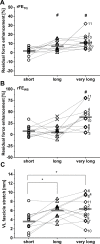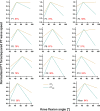Residual force enhancement is affected more by quadriceps muscle length than stretch amplitude
- PMID: 35579415
- PMCID: PMC9129877
- DOI: 10.7554/eLife.77553
Residual force enhancement is affected more by quadriceps muscle length than stretch amplitude
Abstract
Little is known about how muscle length affects residual force enhancement (rFE) in humans. We therefore investigated rFE at short, long, and very long muscle lengths within the human quadriceps and patellar tendon (PT) using conventional dynamometry with motion capture (rFETQ) and a new, non-invasive shear-wave tensiometry technique (rFEWS). Eleven healthy male participants performed submaximal (50% max.) EMG-matched fixed-end reference and stretch-hold contractions across these muscle lengths while muscle fascicle length changes of the vastus lateralis (VL) were captured using B-mode ultrasound. We found significant rFETQ at long (7±5%) and very long (12±8%), but not short (2±5%) muscle lengths, whereas rFEWS was only significant at the very long (38±27%), but not short (8±12%) or long (6±10%) muscle lengths. We also found significant relationships between VL fascicle length and rFETQ (r=0.63, p=0.001) and rFEWS (r=0.52, p=0.017), but relationships were not significant between VL fascicle stretch amplitude and rFETQ (r=0.33, p=0.126) or rFEWS (r=0.29, p=0.201). Squared PT shear-wave-speed-angle relationships did not agree with estimated PT force-angle relationships, which indicates that estimating PT loads from shear-wave tensiometry might be inaccurate. We conclude that increasing muscle length rather than stretch amplitude contributes more to rFE during submaximal voluntary contractions of the human quadriceps.
Keywords: eccentric; force-length relation; human; knee extensors; muscle history dependence; physics of living systems; shear-wave tensiometry.
© 2022, Bakenecker et al.
Conflict of interest statement
PB, TW, DH, BR No competing interests declared
Figures









References
-
- Arampatzis A, Karamanidis K, De Monte G, Stafilidis S, Morey-Klapsing G, Brüggemann G-P. Differences between measured and resultant joint moments during voluntary and artificially elicited isometric knee extension contractions. Clinical Biomechanics (Bristol, Avon) 2004;19:277–283. doi: 10.1016/j.clinbiomech.2003.11.011. - DOI - PubMed
MeSH terms
LinkOut - more resources
Full Text Sources

